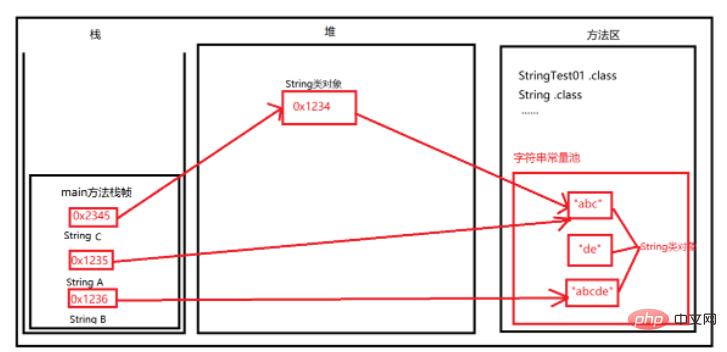String类基本概念
String类属于引用数据类型,不属于基本数据类型。
在Java中只要是" "(双引号)中的,都是String对象。
java中规定,双引号中的字符串是不可变的,也就是说"abc"自出生到死亡都不可能变成"abcd",也不能变成"ab"。
在JDK中双引号括起来的字符串都是存储在方法区的字符串常量池当中的。(因为在实际开发中,字符串的使用频率十分高,为了执行效率,就把字符串放在了方法区中的字符串常量池当中)
String字符串的存储原理
通过 String s = “abc” 这种方式,会在方法区中的字符串常量池创建对象,s会保存该字符串在字符串常量池中的地址。
通过 String s = new String(“abc”)的方式创建对象,首先会在字符串常量池中创建"abc"对象(如果字符串常量池中已经有了"abc"则不会再次创建),然后会在堆区创建String类对象,它会储存" abc "在方法区中的地址,s又会保存堆中String对象的地址。
看以下代码:
public class StringTest01 {
//这两行代码表示创建3个字符串对象,且都在字符串常量池中
String A = "abc";
String B = "abc" + "de";
//通过 new 来创建字符串对象,会先在字符串常量池中寻找"abc"
//找不到的话就会在字符串常量池中创建一个"abc"对象
//在堆中创建创建字符串对象,并且保存"abc"在字符串常量池中的地址
String C = new String("abc");
}按照以上代码画出JVM内存简图如下:

知道了String类字符串的存储原理之后,就可以很容易知道以下代码的编译结果:
public class StringTest01 {
public static void main(String[] args) {
//没有在堆中创建对象
//s1与s2都存的是"hello"在字符串常量池中的地址
String s1 = "hello";
String s2 = "hello";
//在堆中创建了对象
//m,n分别存的是他们在堆中对象的地址
String m = new String("你好!");
String n = new String("你好!");
System.out.println(s1 == s2);//结果为true
System.out.println(m == n);//结果为false
}
}String类的常用构造方法
//String类构造方法的使用
public class StringTest02 {
public static void main(String[] args) {
byte []x1 = { 97 , 98 , 99 };
char []x2 = {'我','是','中','国','人'};
//String s = new String(byte数组);
String y1 = new String(x1);
System.out.println(y1);//ABC
//String s = new String(byte数组,偏移量,长度)
String y2 = new String(x1,1,2);
System.out.println(y2);//BC
//String s = new String(char数组)
String y3 = new String(x2);
System.out.println(y3);//我是中国人
//String s = new String(char数组,偏移量,长度)
String y4 = new String(x2,2,3);
System.out.println(y4);//中国人
}
}String类中常用方法
public class StringTest03 {
public static void main(String[] args) {
//public char charAt(int index)方法
//返回索引值处的char类型字符
char s1 = "中国人".charAt(1);
System.out.println(s1);//国
//public int compareTo(String anotherString)方法
//按字典序比较两个字符串
System.out.println("abc".compareTo("abd"));//负整数
System.out.println("abc".compareTo("abc"));//0
System.out.println("abc".compareTo("abb"));//正整数
//public boolean contains(CharSequence s)方法
//判断字符串是否包含s
System.out.println("abcdefg".contains("efg"));//true
System.out.println("abcdefg".contains("hij"));//false
//public boolean endsWith(String suffix)方法
//判断字符串是否以suffix结尾
System.out.println("abcde".endsWith("cde"));//true
System.out.println("abcde".endsWith("qwe"));//false
//public boolean equalsIgnoreCase(String anotherString) 方法
//判断两个字符串是否相等,忽略大小写
System.out.println("ABcd".equalsIgnoreCase("abCD"));//true
//public byte[] getBytes()
//将字符串转换成byte数组,并返回
byte [] s2 = "abcdefg".getBytes();
for (int i = 0; i < s2.length; i++) {
System.out.print(s2[i] + " ");
}//97 98 99 100 101 102 103
//public int indexOf(String str)
//判断某个子字符串在当前字符串中第一次出现处的索引
//若子字符串不存在,返回-1
System.out.println("abcdefghigk".indexOf("hig"));//7
System.out.println("abc".indexOf("fgh"));//-1
//public int lastIndexOf(String str)
//判断某个子字符串最后一次出现在当前字符串中的索引
System.out.println("abcdhdhdabc".lastIndexOf("abc"));//8
//public boolean isEmpty()
//判断字符串是否为空串
//底层调用length()方法,空串长度为0
//注意:判断数组长度是length属性,判断字符串长度是length()方法
System.out.println("".isEmpty());//true
//public String replace(char oldChar,char newChar)
//返回一个将原字符串中所有的oldChar替换为newChar的新字符串,不改变原字符串
String s3 = "aaatttooo";
System.out.println( s3.replace('t','q'));//aaaqqqooo
//public String replace(CharSequence target,CharSequence replacement)
//CharSequence可以看出String
//将原字符串中的 target 全部换成 replacement
String s4 = "abcsgdjsssjabcjdjjdjabc";
System.out.println(s4.replace("abc","www"));//wwwsgdjsssjwwwjdjjdjwww
//public String[] split(String regex)
//以regex为分界线,将字符串分割保存在一个字符串数组当中,并返回
String s5 = "2022-3-19";
String [] str = s5.split("-");
System.out.println(str[0] + str[1] + str[2]);//2022319
//public String substring(int beginIndex)
//返回一个以索引beginIndex开始直至结尾的字符串
System.out.println("abcdefgh".substring(4));//efgh
//public String substring(int beginIndex,int endIndex)
//返回一个以索引值beginIndex开始,以索引值endIndex结束(不包含该索引值处的字符)的子字符串
System.out.println("abcdefgh".substring(2,5));//cde
//public char[] toCharArray()
//将一个字符串以字符数组的形式返回
char[] str2 = "abcdefg".toCharArray();
for(int i = 0 ; i < str2.length ; i++){
System.out.println(str2[i]);
}
//public String toLowerCase()
//返回一个将原字符串中所有字符变成小写的新字符串
System.out.println("ABcDeFG".toLowerCase());//abcdefg
//public String toUpperCase()
//返回一个将原字符串中所有字符变成大写的新字符串
System.out.println("aCbcdEfg".toUpperCase());//ABCDEFG
//public String trim()
// 返回一个去除字符串的前后空白(空格)的新字符串
System.out.println(" abcdefg ".trim());//abcdefg
//public static String valueOf(参数列表)
//参数列表可以是int型,char型,int数组,对象 等等.......
//String类中唯一一个静态方法,可以直接调用
//将非字符串转换为字符串
//println()底层调用的就是valueOf()方法,只要是打印在控制台上的都是字符串
System.out.println(String.valueOf(true));
}
}StringBuffer类
思考:
频繁使用字符串拼接会有什么影响?
java中字符串是不可变的,每拼接一次都会产生一个新的字符串
字符串是存在字符串常量池中的,频繁使用字符串拼接会占用大量的方法区空间
为了避免以上问题我们就可以使用到StringBuffer类
//java.lang.StringBuffer
public class StringBufferTest {
public static void main(String[] args) {
//创建一个初始化容量为16个 byte[] 数组(字符串缓冲区对象)
StringBuffer strBuffer = new StringBuffer();
//拼接字符串调用 append()方法
//append()方法底层会调用 System.arraycopy()方法,效率较低
//append()再追加时,如果byte[]满了之后会自动扩容
strBuffer.append(1);
strBuffer.append('q');
strBuffer.append(3.14);
strBuffer.append("abc");
System.out.println(strBuffer);//1q3.14abc
//StringBuffer可以进行一定的优化
//在创建StringBuffer时尽可能可能给定一个合适的初始化容量
//从而减少底层数组的扩容次数
//指定初始化容量的字符串缓冲区
StringBuffer newstrBuffer = new StringBuffer(100);
}
}StringBuilder类
它的用法与StringBuffer十分相似,但是也有很大的区别:
StringBuffer中的方法都有synchronized关键字修饰,表示StringBuffer在多线程编译环境下是安全的
StringBuilder中方法没有synchronized关键字修饰,表示StringBuilder在多线程编译环境下是不安全的
以上是如何在Java中使用String类、StringBuffer和StringBuilder?的详细内容。更多信息请关注PHP中文网其他相关文章!
 如何将Maven或Gradle用于高级Java项目管理,构建自动化和依赖性解决方案?Mar 17, 2025 pm 05:46 PM
如何将Maven或Gradle用于高级Java项目管理,构建自动化和依赖性解决方案?Mar 17, 2025 pm 05:46 PM本文讨论了使用Maven和Gradle进行Java项目管理,构建自动化和依赖性解决方案,以比较其方法和优化策略。
 如何使用适当的版本控制和依赖项管理创建和使用自定义Java库(JAR文件)?Mar 17, 2025 pm 05:45 PM
如何使用适当的版本控制和依赖项管理创建和使用自定义Java库(JAR文件)?Mar 17, 2025 pm 05:45 PM本文使用Maven和Gradle之类的工具讨论了具有适当的版本控制和依赖关系管理的自定义Java库(JAR文件)的创建和使用。
 如何使用咖啡因或Guava Cache等库在Java应用程序中实现多层缓存?Mar 17, 2025 pm 05:44 PM
如何使用咖啡因或Guava Cache等库在Java应用程序中实现多层缓存?Mar 17, 2025 pm 05:44 PM本文讨论了使用咖啡因和Guava缓存在Java中实施多层缓存以提高应用程序性能。它涵盖设置,集成和绩效优势,以及配置和驱逐政策管理最佳PRA
 如何将JPA(Java持久性API)用于具有高级功能(例如缓存和懒惰加载)的对象相关映射?Mar 17, 2025 pm 05:43 PM
如何将JPA(Java持久性API)用于具有高级功能(例如缓存和懒惰加载)的对象相关映射?Mar 17, 2025 pm 05:43 PM本文讨论了使用JPA进行对象相关映射,并具有高级功能,例如缓存和懒惰加载。它涵盖了设置,实体映射和优化性能的最佳实践,同时突出潜在的陷阱。[159个字符]
 Java的类负载机制如何起作用,包括不同的类载荷及其委托模型?Mar 17, 2025 pm 05:35 PM
Java的类负载机制如何起作用,包括不同的类载荷及其委托模型?Mar 17, 2025 pm 05:35 PMJava的类上载涉及使用带有引导,扩展程序和应用程序类负载器的分层系统加载,链接和初始化类。父代授权模型确保首先加载核心类别,从而影响自定义类LOA


热AI工具

Undresser.AI Undress
人工智能驱动的应用程序,用于创建逼真的裸体照片

AI Clothes Remover
用于从照片中去除衣服的在线人工智能工具。

Undress AI Tool
免费脱衣服图片

Clothoff.io
AI脱衣机

AI Hentai Generator
免费生成ai无尽的。

热门文章

热工具

ZendStudio 13.5.1 Mac
功能强大的PHP集成开发环境

PhpStorm Mac 版本
最新(2018.2.1 )专业的PHP集成开发工具

Dreamweaver CS6
视觉化网页开发工具

VSCode Windows 64位 下载
微软推出的免费、功能强大的一款IDE编辑器

Dreamweaver Mac版
视觉化网页开发工具






